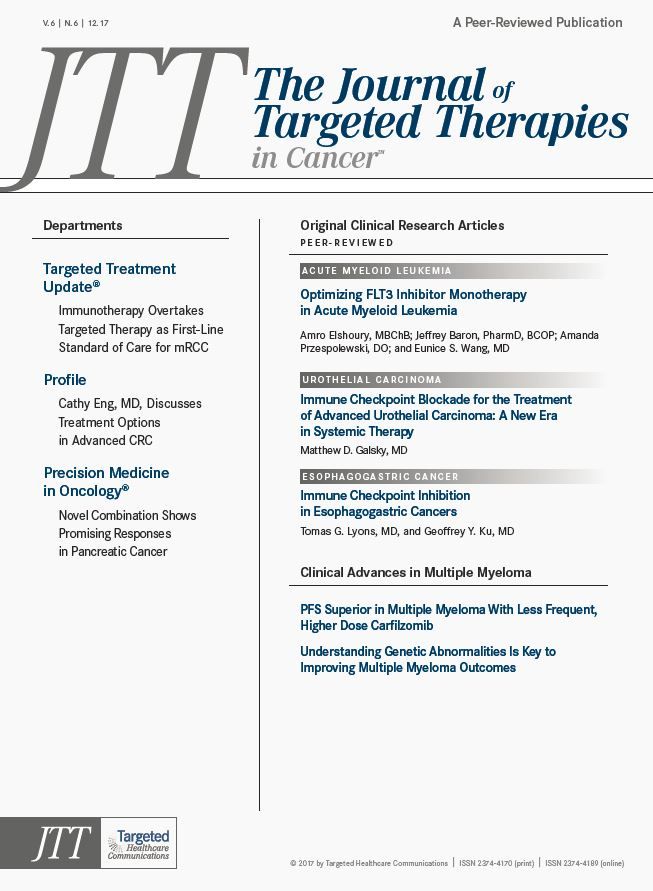Novel Combination Shows Promising Responses in Pancreatic Cancer
The combination of the novel tumor-associated macrophage (TAM)-targeting agent cabiralizumab and the PD-1 inhibitor nivolumab (Opdivo) resulted in intriguing objective response rates in heavily pretreated patients with metastatic pancreatic cancer, according to findings from a phase I study presented at the 2017 SITC Annual Meeting.
Zev Wainberg, MD
The combination of the novel tumor-associated macrophage (TAM)-targeting agent cabiralizumab and the PD-1 inhibitor nivolumab (Opdivo) resulted in intriguing objective response rates in heavily pretreated patients with metastatic pancreatic cancer, according to findings from a phase I study presented at the 2017 SITC Annual Meeting.
At the time of the presentation, cabiralizumab plus nivolumab elicited a confirmed objective response in 4 of 31 (13%) efficacyevaluable heavily pretreated patients with pancreatic cancer. Three of the 4 responding patients continued to receive treatment with the combination (range, 168+ to 275+ days) and 1 additional patient had stable disease (disease control rate, 16%). Along with reductions in tumor burden, a marked reduction was seen in CA19-9 levels for those with confirmed responses.
“All 4 confirmed responses were observed in patients with microsatellite stable disease, who historically have not shown benefit with anti‒PD-1 or PD-L1 therapy,” lead investigator Zev Wainberg, MD, assistant professor of medicine at UCLA and co-director of the UCLA GI Oncology Program, said during his presentation of the results.
“Further cohort expansion is ongoing as well as additional biomarker analyses.”
Cabiralizumab inhibits CSF-1R6 leading to depletion of TAMs, which are thought to be associated with prevention of an antitumor immune response in the tumor microenvironment. In preclinical findings, synergy was seen between CSF-1R and PD-1 inhibition, establishing the rationale behind the firstin-human study.
In the phase I study, patients received cabiralizumab alone (n = 24) or in combination with nivolumab (n = 10) in a dose escalation cohort across several solid tumors. Doses of cabiralizumab ranged from 1 mg/kg to 6 mg/kg and nivolumab was given at a 3 mg/kg dose.
Treatment with both antibodies was administered intravenously every 2 weeks. An optimal dose of 4 mg/kg of cabiralizumab plus nivolumab at 3 mg/kg was further explored in a dose expansion cohort in 195 patients.
Patients in the monotherapy arm had a median age of 65.5 years, an ECOG performance status (PS) of 0 (29%) or 1 (71%), and 71% had received ≥3 prior regimens. In the combination arm, the median age of patients was 64 years, 27% had an ECOG PS of 0 and 71% had a score of 1. Overall, 45% of patients had received ≥3 prior regimens, 28% had received 2 and 23% had received 1. Seven patients were treated in the frontline setting (3%).
Pharmacokinetic data were similar for cabiralizumab when administered as a monotherapy and in combination with nivolumab, Wainberg noted, and the combination showed low immunogenicity, he added. The 4 mg/kg dose was selected for the expansion cohort after showing similar serum concentrations after the first dose as the higher 6 mg/kg dose, suggesting saturation of target-mediated clearance. Additionally, depletion of circulating nonclassical monocytes, a pharmacodynamic marker of CSF-1R inhibition, was not seen until the dose reached 4 mg/kg.
Efficacy findings were presented solely for patients with pancreatic cancer at the SITC meeting, although adverse events (AEs) were described across the full study. The pancreatic cancer cohort contained 33 patients treated in the dose expansion stage of the study. The median age was 64 years, 58% had ECOG PS of 1, and 45% had received ≥3 prior regimens.
In the pancreatic cancer group, the most common treatment-related AEs (TRAEs) of all grades were serum enzyme elevations (52%), fatigue (42%), periorbital edema (30%), rash (21%), and vomiting (21%). The most common grade 3/4 TRAEs were serum enzyme elevations (33%), hyponatremia (9%), and rash maculopapular (9%). In 9% of patients there was treatment discontinuation due to AEs, all of which were grade 3/4 in severity
Across all patients treated with the combination, the most common grade 3/4 TRAEs were serum enzyme elevations (20%), pancreatic enzyme elevations (12%), fatigue (5%), rash (4%), pruritus (1%), and periorbital edema (<1%). There were 3 treatment-related deaths in the combination arm, these were due to pneumonitis in a patient with thyroid cancer (n = 1) and respiratory distress (n = 1) and acute respiratory distress (n = 1) in patients with lung cancer. The most frequently observed grade 3/4 TRAEs with cabiralizumab monotherapy were serum enzyme elevation (38%), pancreatic enzyme elevations (8%), and rash (4%).
“The most common treatment-related AEs were elevations in creatine kinase and serum liver enzymes, without elevation in bilirubin,” said Wainberg. “These are believed to be secondary to cabiralizumab’s depletion of macrophages and might represent a class effect of CSF-1R inhibition. Isolated serum enzyme elevations were not associated with other clinical presentation.”
A phase II study is currently enrolling to explore the combination of cabiralizumab and nivolumab with or without chemotherapy for patients with advanced pancreatic cancer. Chemotherapy agents in the trial will consist of nab-paclitaxel (Abraxane), gemcitabine, irinotecan liposome injection (Onivyde), or the FOLFIRINOX chemotherapy. The primary endpoint of the study, which plans to enroll 160 patients, is progression-free survival (NCT03336216).
Reference:
Wainberg ZA, Piha-Paul SA, Luke JJ, et al. First-in-human phase 1 dose escalation and expansion of a novel combination, antiCSF-1 receptor (cabiralizumab) plus anti–PD-1 (nivolumab), in patients with advanced solid tumors. Presented at: 32nd SITC Annual Meeting; November 8-12, 2017; National Harbor, MD. Abstract O42. https://higherlogicdownload.s3.amazonaws. com/SITCANCER/3bcb5ebf-803a-42fe-83b6-0773bc4eb962/UploadedImages/Annual%20Meeting%202017/SITC_2017_Abstract_Book.pdf.

Gasparetto Explains Rationale for Quadruplet Front Line in Transplant-Ineligible Myeloma
February 22nd 2025In a Community Case Forum in partnership with the North Carolina Oncology Association, Cristina Gasparetto, MD, discussed the CEPHEUS, IMROZ, and BENEFIT trials of treatment for transplant-ineligible newly diagnosed multiple myeloma.
Read More